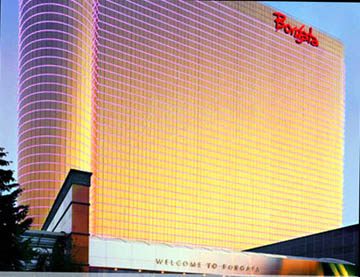
History of Atlantic City, NJ
History
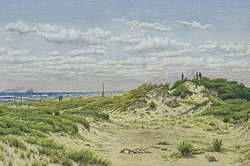
Absecon Island 1894
Water Color Art by
Peter Caledon Cameron
Atlantic City is located on Absecon Island, a 5-mile long barrier island, which the Lenni-Lenape Indians inhabited during the summer months.
The first record of land ownership on Absecon Island was by Thomas Budd, who had to accept the island, against his desire, as part of a purchase of 15,000 acres he bought on the mainland from William Penn and a group of Quakers. As Budd considered the land on the island worthless, he eventually sold it off at about $4 an acre. Jeremiah Leeds became one of the land owners and became the first white man to settle on Absecon Island. He built a permanent residence on the island in 1785, on what was then known as "Leeds Plantation." By 1850 there were seven permanent dwellings on the island.
Johnathan Pitney, a doctor on the mainland, visited the island by rowboat to treat patients. He recognized the potential of the island to become a resort for the wealthy because of it's beautiful beaches and clean salt air. Pitney interested Samuel Richards, a South Jersey landowner, in the idea. He joined Pitney, and provided the influence, financing, and drive to make it happen.
The key to developing Absecon Island was the building of a railroad to transport visitors from Philadelphia. Samuel Richards obtained the required charter from the State of New Jersey, and lined up the needed investors that included Pitney and himself. The Camden-Atlantic Railroad was built to the edge of the Bay, and began operation in 1854. A bridge linking the mainland to the island was completed a few months later.
Initially business was slow, but by 1874 almost 500,000 passengers a year were coming to Atlantic City by rail. Boarding houses and hotels began opening along the beach, and the first version of the boardwalk was built in 1872 to keep hotel patrons from tracking sand into the hotel lobbies.
The name "Atlantic City" was proposed by Richard Osborne, a civil engineer from Philadelphia, who laid out the street plan for the city.
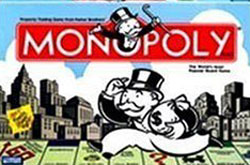
The City's streets running parallel to ocean were named after the world's oceans, particularly the Pacific, Atlantic, Mediterranean, Adriatic and Artic. The streets running perpendicular to the ocean were named after the American states. The Monopoly game was based on Atlantic City and these street names.
A second railroad, called the Philadelphia-Atlantic City Railroad was built, and began operation in 1877. Railroad fares were kept low, so that workers in the mills and factories of Philadelphia could afford the train ride to Atlantic City. They came by the thousands on weekends and their days off. They strolled and paraded on the boardwalk wearing, and showing off their finest attire and enjoying the fresh air and views of the sea.
The resulting influx of visitors from both Philadelphia and also New York, triggered major building projects that included large and elaborate hotels, amusement piers, and expansion of the boardwalk.
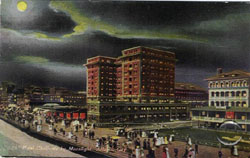
Chalfont - Haddon Hall
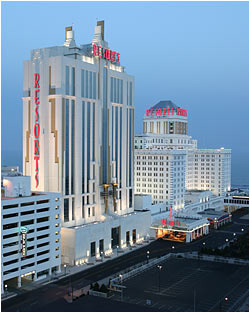
Resorts Casino Hotel
One of the most lxurious hotels was the Chalfonte-Haddon Hall, which was later converted into the Resorts Casino Hotel.
Atlantic City was run as a wide open town, with the local politicians ignoring existing blue laws. During prohibition liquor flowed freely and gambling regularly took place in the back rooms of nightclubs and restaurants.
Through the 1920's and up to about 1960, Atlantic City was one of the most popular tourist destinations in the United States. In its prime, the nation's most popular entertainers regularly performed there. During the 1950s Frank Sinatra regularly appeared at Atlantic City clubs. Atlantic City became one of the most famous resorts in the world.
The city's popularity eventually decreased as low-cost, fast, jet air travel became available. Tourists started heading elsewhere, including Miami Beach, Florida and the Caribbean.
Atlantic City went through a decline and then a rebirth, with casino gambling being the catalyst for its resurgence. The first casino, Resorts, opened in Atlantic City in 1978, and it soon became a big destination for senior citizen day trippers.
Most of the City's hotels were converted to casinos, or demolished and replaced by bigger and more elaborate casinos. Tourist began coming back to Atlantic City in big numbers.
The present trend is for even larger casinos which are designed to appeal to a more up-scale clientele. The Borgata opened in 2003, introducing a new era with restaurants from big name-chefs, pulsing night clubs, and up-scale shopping, and no drop-off zones for buses full of senior citizens.
Atlantic City now has 9 casinos, and it has the boardwalk, the beach and the ocean.
Glimpses of the Past
To see many examples of what Atlantic City looked like during the late 1800's and early to mid 1900's, follow the links below:
Links:
